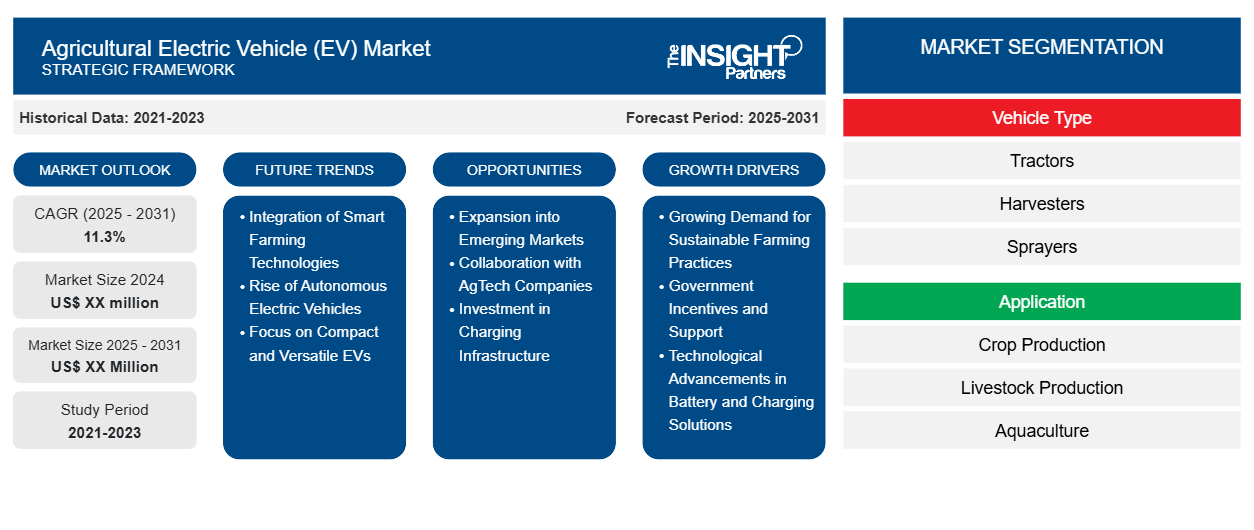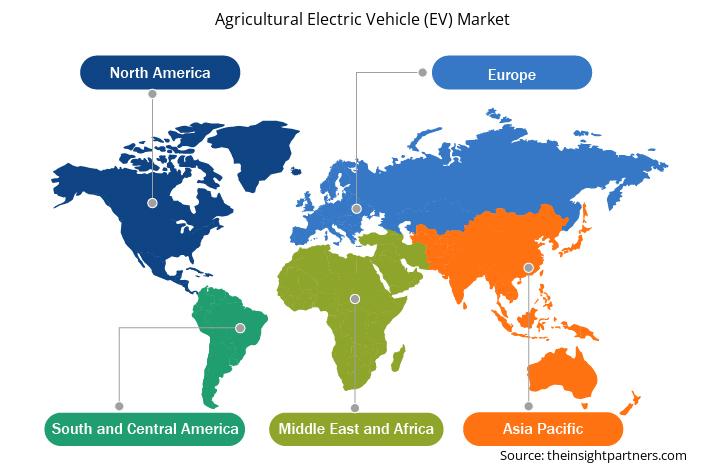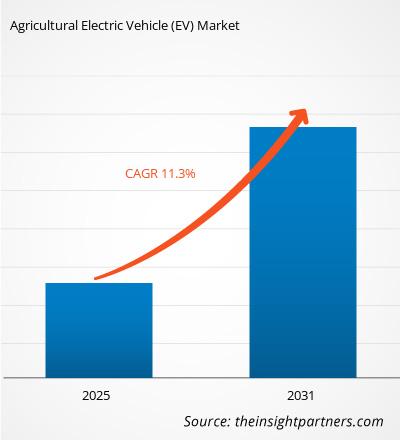農業用電気自動車(EV)市場は、2025年から2031年にかけて11.3%のCAGRで成長し、市場規模は2024年のXX百万米ドルから2031年にはXX百万米ドルに拡大すると予想されています。
本レポートは、車両タイプ(トラクター、ハーベスター、スプレーヤー)、用途(作物生産、畜産、養殖)別にセグメント化されています。グローバル分析は、地域レベルと主要国別にさらに細分化されています。本レポートでは、上記の分析とセグメントの米ドル建て価値を提供しています。
報告書の目的
The Insight Partnersによる農業用電気自動車(EV)市場レポートは、現在の市場状況と将来の成長、主要な推進要因、課題、そして機会を解説することを目的としています。これにより、以下のような様々なビジネスステークホルダーに洞察を提供します。
- テクノロジープロバイダー/メーカー: 進化する市場の動向を理解し、潜在的な成長機会を把握することで、情報に基づいた戦略的意思決定を行うことができます。
- 投資家: 市場の成長率、市場の財務予測、バリュー チェーン全体に存在する機会に関する包括的な傾向分析を実施します。
- 規制機関: 市場の濫用を最小限に抑え、投資家の信用と信頼を維持し、市場の健全性と安定性を維持することを目的として、市場における政策と警察活動を規制します。
農業用電気自動車(EV)市場のセグメンテーション
車両タイプ
- トラクター
- 収穫機
- 噴霧器
応用
- 作物生産
- 畜産
- 養殖業
要件に合わせてレポートをカスタマイズ
このレポートの一部、国レベルの分析、Excelデータパックなど、あらゆるレポートを無料でカスタマイズできます。また、スタートアップや大学向けのお得なオファーや割引もご利用いただけます。
農業用電気自動車(EV)市場:戦略的洞察

- このレポートの主要な市場動向を入手してください。この無料サンプルには、市場動向から見積もりや予測に至るまでのデータ分析が含まれます。
農業用電気自動車(EV)市場の成長要因
- 持続可能な農業慣行への需要の高まり:
農業分野では、環境問題への対応と二酸化炭素排出量の削減のため、持続可能な農業慣行の導入が進んでいます。この変化は、従来のディーゼル駆動機械に代わる、よりクリーンで効率的な代替手段として電気自動車の需要を促進しています。農家は、排出量の削減、燃料費の削減、そして作業効率の向上といった電気自動車のメリットを認識しています。持続可能性が優先事項となるにつれ、農業用電気自動車の需要は大幅に増加すると予想されます。EVs in reducing emissions, lowering fuel costs, and enhancing operational efficiency. As sustainability becomes a priority, the demand for agricultural electric vehicles is expected to grow significantly. - 政府のインセンティブと支援:
世界中の多くの政府が、農業分野を含む電気自動車の導入を促進するための政策を実施し、インセンティブを提供しています。これらのインセンティブには、電気農業機械の購入に対する税制優遇措置、助成金、補助金などが含まれます。さらに、政府は農村部における電気自動車の導入を支援するため、充電インフラへの投資も行っています。こうした支援策により、電気自動車は農家にとってより身近なものとなり、経済的にも実現可能となり、市場の成長をさらに促進しています。EV adoption in rural areas. Such supportive measures are making electric vehicles more accessible and financially viable for farmers, further propelling market growth. - バッテリーと充電ソリューションにおける技術の進歩:
バッテリー技術と充電ソリューションの近年の進歩は、農業用電気自動車市場に大きな影響を与えています。バッテリー容量、効率、寿命の向上により、電気自動車はより長時間の稼働と長距離走行が可能になっています。さらに、急速充電ステーションの開発により、ターンアラウンドタイムが短縮され、電気自動車は農業においてより実用的になっています。技術の進歩が進むにつれて、電気自動車の魅力は高まり、農業への導入が促進されるでしょう。
農業用電気自動車(EV)市場の将来動向
- スマート農業技術の統合:
農業用EV市場では、スマート農業技術の統合が進む傾向にあります。電気自動車には、農作業を最適化するために、高度なセンサー、GPS、IoT接続機能が搭載されるケースが増えています。こうした統合により、精密農業が可能になり、農家は作物、土壌の状態、機械の性能をリアルタイムで監視できるようになります。スマート農業の普及に伴い、これらの技術をサポートする電気自動車の需要が高まり、市場におけるイノベーションを促進することが期待されます。 - 自動運転電気自動車の台頭:
もう一つの注目すべきトレンドは、農業における自動運転電気自動車の台頭です。これらの自動運転機械は、植え付け、収穫、圃場の監視など、様々な作業を人間の介入なしに実行できます。電力と自動化を組み合わせることで、効率性が向上するだけでなく、人件費も削減されます。農家が生産性向上と作業効率化の方法を模索する中で、自動運転電気自動車への関心は高まり、農業の未来を形作っています。 - コンパクトで多用途なEVへの注力:
小規模な圃場を走行し、多様な農業環境で稼働できる、コンパクトで多用途な電気自動車の需要が高まっています。農家は、環境に優しいだけでなく、輸送から畑作業まで、複数の作業をこなせる車両を求めています。この傾向を受け、メーカーは現代農業の多様なニーズに対応できる、より小型で機敏な電気自動車の開発に注力し、市場での魅力を高めています。
農業用電気自動車(EV)市場の機会
- 新興市場への進出:
新興市場は、農業用電気自動車市場にとって大きなビジネスチャンスをもたらします。これらの地域では急速な都市化と農業の近代化が進んでおり、効率的な農業ソリューションへのニーズが高まっています。電気自動車は、生産性の向上と環境への影響の最小化において重要な役割を果たすことができます。これらの市場に戦略的に参入する企業は、持続可能な農業慣行への高まる需要を捉え、長期的な成長と成功に向けた体制を整えることができます。 - アグテック企業との連携:
電気自動車メーカーとアグテック企業の連携は、製品ラインナップを強化する絶好の機会となります。テクノロジー企業との提携により、メーカーは精密農業ツール、データ分析、遠隔監視システムといった革新的なソリューションを電気自動車に統合することができます。こうした連携は、より高度で効率的な農業ソリューションの開発につながり、農業経営を最適化するための包括的なツールを求めるテクノロジーに精通した農家にとって魅力的なものとなるでしょう。 - 充電インフラへの投資:
堅牢な充電インフラの整備は、農業用電気自動車市場にとって極めて重要な機会です。電気自動車の台数が増加するにつれて、信頼性が高くアクセスしやすい充電ステーションの需要は高まります。企業や政府は、農村地域に特化した充電ネットワークの構築に投資することで、農家が電気自動車を導入するために必要な支援を確実に受けられるようにすることができます。こうしたインフラへの投資は、農業における電気自動車の実現可能性を大幅に高め、より広範な導入を促進する可能性があります。
農業用電気自動車(EV)市場の地域別分析
Insight Partnersのアナリストは、予測期間を通じて農業用電気自動車(EV)市場に影響を与える地域的なトレンドと要因を詳細に解説しています。本セクションでは、北米、ヨーロッパ、アジア太平洋、中東・アフリカ、中南米における農業用電気自動車(EV)市場のセグメントと地域についても解説します。

- 農業用電気自動車(EV)市場の地域別データを入手
農業用電気自動車(EV)市場レポートの範囲
| レポート属性 | 詳細 |
|---|---|
| 2024年の市場規模 | XX百万米ドル |
| 2031年までの市場規模 | XX百万米ドル |
| 世界のCAGR(2025年~2031年) | 11.3% |
| 履歴データ | 2021-2023 |
| 予測期間 | 2025~2031年 |
| 対象セグメント | 車種別
|
| 対象地域と国 | 北米
|
| 市場リーダーと主要企業の概要 |
|
農業用電気自動車(EV)市場のプレーヤー密度:ビジネスダイナミクスへの影響を理解する
農業用電気自動車(EV)市場は、消費者の嗜好の変化、技術の進歩、製品メリットへの認知度の向上といった要因によるエンドユーザー需要の高まりに牽引され、急速に成長しています。需要の高まりに伴い、企業は製品ラインナップの拡充、消費者ニーズへの対応のためのイノベーション、そして新たなトレンドの活用を進めており、これが市場の成長をさらに加速させています。
市場プレーヤー密度とは、特定の市場または業界内で事業を展開する企業または会社の分布を指します。これは、特定の市場空間における競合企業(市場プレーヤー)の数が、その市場規模または市場価値全体と比較してどれだけ多いかを示します。
農業用電気自動車(EV)市場で事業を展開している主要企業は次のとおりです。
- マヒンドラ&マヒンドラ
- ヤンマー
- ソリス
- キオティトラクター
- ズームライオン
免責事項:上記の企業は、特定の順序でランク付けされているわけではありません。

- 農業用電気自動車(EV)市場の主要な主要プレーヤーの概要を入手
主なセールスポイント
- 包括的なカバレッジ:レポートでは、農業用電気自動車 (EV) 市場の製品、サービス、タイプ、エンドユーザーの分析を包括的にカバーし、全体的な展望を提供します。
- 専門家の分析:レポートは、業界の専門家とアナリストの深い理解に基づいて作成されています。
- 最新情報: このレポートは、最新の情報とデータの傾向を網羅しているため、ビジネスの関連性を保証します。
- カスタマイズ オプション: このレポートは、特定のクライアント要件に対応し、ビジネス戦略に適切に適合するようにカスタマイズできます。
したがって、農業用電気自動車(EV)市場に関する調査レポートは、業界の状況と成長見通しを解明し、理解するための先導役となるでしょう。いくつかの妥当な懸念事項はあるものの、このレポートの全体的なメリットはデメリットを上回る傾向にあります。
- 過去2年間の分析、基準年、CAGRによる予測(7年間)
- PEST分析とSWOT分析
- 市場規模価値/数量 - 世界、地域、国
- 業界と競争環境
- Excel データセット
最新レポート
お客様の声
購入理由
- 情報に基づいた意思決定
- 市場動向の理解
- 競合分析
- 顧客インサイト
- 市場予測
- リスク軽減
- 戦略計画
- 投資の正当性
- 新興市場の特定
- マーケティング戦略の強化
- 業務効率の向上
- 規制動向への対応




















 無料サンプルを入手 - 農業用電気自動車(EV)市場
無料サンプルを入手 - 農業用電気自動車(EV)市場